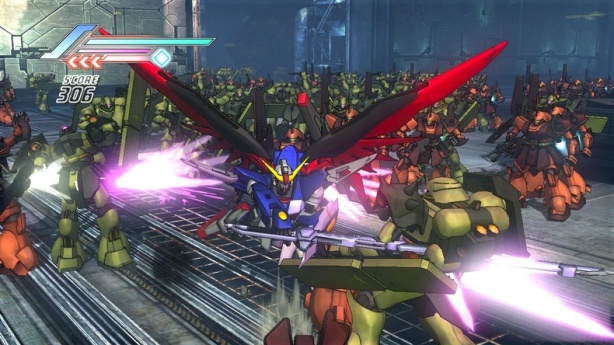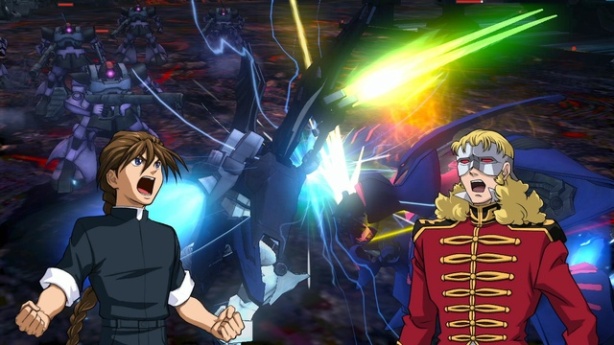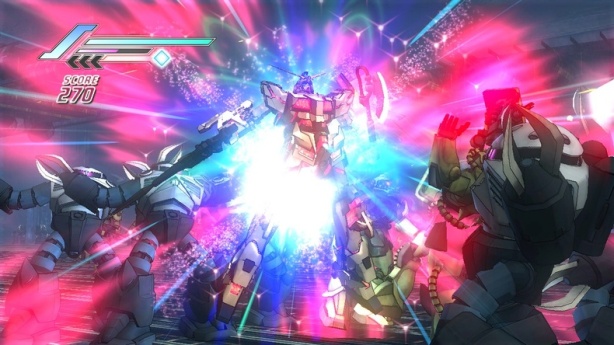Dynasty Warriors: Gundam 3 Review
 Game: Dynasty Warriors: Gundam 3
Game: Dynasty Warriors: Gundam 3
Developer: Koei, Omega Force
Publisher: Tecmo Koei Europe
Available on: Xbox 360, PlayStation 3 (Xbox 360 version reviewed)
Spanning over thirty different films and television series and over a hundred video games, the vast, sprawling Gundam universe is a daunting prospect for any newcomer. Revolving around giant robots, or “mecha”, it has spent three decades gathering fans and confusing outsiders in equal measure. One of the highest-profile iterations of the meta-series for Western audiences in recent years has been Dynasty Warriors: Gundam, which uses Dynasty Warriors’ strategic hack-and-slash mechanic as a platform to allow players to pilot Gundam’s famous mecha: the Mobile Suits.
Players who aren’t well-versed in Gundam legend will probably find the plot fairly heavy going. Similarly, anyone not familiar with hack-and-slash conventions will struggle to figure out what’s going on in the first few stages of the game. But once players have got over their initial teething troubles, is the Dynasty Warriors: Gundam 3 experience worth the hassle?
STORY: Told from the perspective of a number of different characters, Gundam’s epic science-fiction storyline depicts a universe torn apart by war. The player’s ability to follow the various plot lines is dependent on their previous knowledge of the Gundam universe, and this is likely to divide opinion. Whilst many will find it hugely frustrating, others will applaud the game’s decision to focus on the experience of long-term fans over newcomers.
There is no denying that much of the plot will sail over the heads of the uninitiated, something that isn’t helped by the game’s questionable use of text-based exposition. Aside from the spectacular cinematics that punctuate the core missions in story mode, much of the narrative is conveyed by either static dialogue between the characters, or messages on the game’s central “terminal”. Further to this, characters frequently appear on the battlefield without any introduction, leaving anyone unfamiliar with the series unsure as to why they require annihilation, other than the fact that their energy bar is red, rather than blue.
However, the questionable narrative devices are arguably unimportant. Firstly, for those new to the series, being unaware of the reasons why you’re fighting doesn’t necessarily make it any less enjoyable (again: giant robots). Secondly, long-term fans of the series will be able to simply enjoy the appearance of their favourite characters without any protracted and intrusive introduction sequences. It’s also worth bearing in mind that there is so much content elsewhere in the game that perhaps the decision to focus developer hours and disk space on the Mobile Suits rather than the narrative was a wise one.
GRAPHICS: The most instantly noticeable thing about the game is the striking use of cel-shaded graphics and static backgrounds to re-create the look of the original anime. The cinematic sequences which make use of this effect are truly stunning, and manage to combine the distinctive aesthetic of the television show with the kind of polish that gamers at the latter end of the current generation demand.
The battles themselves might not be as astonishingly beautiful as the cinematics, but they are clearly-rendered and never confusing, which is quite a feat when you stop to consider the fact that there are often hundreds of enemies on screen at any one time. The decision to use cel-shading results not only in a beautiful game, but also a coherent one, as each Mobile Suit on the field is defined with sharp lines and distinctive colours.
That said, despite the clarity of the graphics, there is sometimes so much information being conveyed on the HUD that it can obscure gameplay. At any one moment, the HUD is likely to contain not only a large dialogue box flanked with a picture of the character, but also your suit’s status, the map, and the meter which measures the morale of both your side and your enemy’s. Whilst much of this is necessary information that you’ll need (to make strategic decisions during battle), it is debatable that so much screen real-estate should be given over to the dialogue boxes. Granted, it’s unlikely that even the most seasoned Gundam fan would know who was talking without them, but such utterances are rarely important to the plot, and there are times when they will obstruct your view of an enemy approaching from behind.
SOUND: The one part of the game that’s unarguably mediocre, Dynasty Warriors: Gundam 3 features a soundtrack as banal as it is repetitive. Battles are accompanied by a monotonous yet tinny electronic dirge that you can neither tune out nor grow to enjoy. It adds nothing in the way of atmosphere, and does not develop as the stakes are raised. Given the amount of time you will spend listening to it, this is a shame, but thankfully it’s so unimportant that you probably won’t miss much if you decide to listen to your own music instead.
The voice acting is certainly no worse than most Japanese-to-English dubs, and many players will be pleased to find out that the entire game can be played with a (far superior) Japanese voice-over instead. Because all the dialogue is subtitled anyway, this is recommended, although there will always be those who prefer an English-language voice over.
Whichever language you choose however, be prepared for the fact that your character will repeat the same words and phrases every time you execute various attacks. There are two ways of looking at this. One is to grit your teeth with frustration, angered that your character doesn’t have anything more to say for themselves. The other is to view this as an incentive to stop mashing buttons and learn some alternative combos. Not only will you be rewarded with some new phrases, but you’ll die a lot less, too.
GAMEPLAY: There’s really only one major criticism that it is possible to make regarding the gameplay, and that is that for the first hour or two, it is almost impossible to fathom what is going on. The battle system is conveyed awkwardly through a confusing tutorial which covers high-level gameplay mechanics (such as which strategic assets it is best to capture first), without actually discussing the most basic controls. However, the simple-yet-deep combo system that forms most of the gameplay will be picked up quickly by most players, and it develops in a logical way throughout the game. A combo list can be accessed via the pause menu, but a more intuative tutorial would certainly give the game a smoother take-off.
Story mode consists of a series of battles that, once unlocked, can be played in any order. Although these take on a variety of guises, the basics are largely the same. Taking on the role of pilot, you control a Mobile Suit and use a variety of melee and ranged attacks to cut down armies of drones and tough bosses to conquer a battlefield. These battlefields are divided into a number of large square areas linked by corridors, representing bases that can be occupied by both player and enemy forces. Some bases are of extra strategic advantage because they contain ranged weapons or a catapult that can launch the player’s Mobile Suit from one side of the battlefield to the other. Victory is acquired by fulfilling certain conditions, most of which involve defeating a boss. Whilst a good way of showcasing the brilliant fighting mechanics, maps are somewhat lacking in variety, and are unlikely to tax a player’s strategic abilities too much.
The fighting itself is excellent. Whilst all suits have the same basic controls, there is astonishing variation between their different moves and abilities, and that’s before you have started upgrading them. Combos are challenging yet intuitive, and reward players with visceral pyrotechnic displays that slice through hordes of enemy mecha. The difficulty curve is fairly steep, and button-mashers will struggle to get past the first few stages, though the game sensibly allows players to select the difficulty before every battle. Another godsend is the “interim save” feature, which allows players to save their game in the midst of a mission. Far from being a cop-out, this feature makes perfect sense in a game where even the best-laid plans can’t prevent two-hit destruction from a fully-charged boss. Players can also avoid disaster by utilising the “Partner Strike”, where a pre-chosen ally can be summoned into battle at the cost of a portion of their SP gauge.
At the heart of Dynasty Warriors: Gundam 3 are the Mobile Suits themselves, and upgrading and customising them forms a large part of the gameplay. As you defeat enemies in battle, you unlock the plans to the relevant suit, which you are then able to develop and customise. Developing a suit involves improvising on basic statistics such as melee attack power, armour and manoeuvrability, whilst customising allows you to add new abilities, providing you have enough free slots. Further depth is added by the fact that characters can only pilot suits for which they have a licence, meaning that players must make strategic decisions about which licences they purchase.
The range of suits is breathtaking, and hugely rewarding for long-term fans, who will recognise beautifully rendered suits from across the series. Whilst some (such as Setsuna’s catchily-named GN-0000+GNR-010 00 Raiser) yield instant rewards, others are weak and unwieldy, even after a couple of upgrades. Rather than being an annoyance, however, this adds scale and complexity to the world, presenting an entertaining challenge. The game’s various menus are explained in rather more depth than its gameplay, which is a good thing given their complexity. Further to this, they’re logically arranged and easy to navigate, so upgrading suits and buying licences is never a chore.
Story mode contains several auxiliary game modes, which are typically more difficult than the core missions. These extra missions give players the chance to unlock further Mobile Suits or upgrades, earn gold or obtain rare Pilot Skills. Some, such as the History Missions, are specifically geared towards long-term fans of the series, as they allow players to re-enact battles from the original series.
MULTIPLAYER: Dynasty Warriors: Gundam 3 features fifteen unique co-operative missions for up to four players online, each of which highlights the necessity of co-operation. The gold and other rewards earned during these missions are proportionately higher than those gained during single-player play, so there’s a large incentive to join the online community.
The game also includes a very welcome two-player couch co-operative feature, in which a second player can join in various battles in story mode. Although it’s nice that there is at least some scope for couch co-op, it would have been nice for every mission in story mode to support this feature so that two players could play through the story together. It’s also a shame that many of the “History” missions don’t support it, so a pair of long-term Gundam fans can’t wallow in nostalgia together.
LONGEVITY: Even if the game was a purely single-player experience, the sheer volume of high-quality content it contains would still make it one of the best-value games on the market. There is astonishing variety between the different Mobile Suits, and the fact that you can not only customise them but man each one with fifty different pilots means that you are unlikely to grow weary of it for at least a month. The rewards you get for each mission make their completion compulsive, and fans will be keen to uncover as much of the content as they possibly can.
The fact that the game also contains a fairly hefty multiplayer mode is just delicious icing on an already substantial cake. There is also the promise of future DLC, so if you’re looking for a game that will take you through the summer, this is a strong candidate.
VERDICT: Dynasty Warriors: Gundam 3 takes no prisoners. It does not make allowances for any players new to either the franchise or the nuances of Mobile Suits. If you don’t already know who the characters are, the game makes no effort to enlighten you. This, together with the confusing and awkwardly conveyed narrative, makes Gundam 3 surprisingly inaccessible for a mainstream console title.
Yet there is something admirable in the game’s refusal to compromise its core values for the sake of enticing new players into the fold. Whilst a more explicit tutorial (especially on the basic fighting mechanics) certainly wouldn’t go amiss, the overall complexity of the game presents a refreshing contrast to the hordes of franchises falling over themselves to appeal to the widest possible audience. It rewards the long-term fans who made the Gundam series successful in the first place by adhering faithfully to its source material, something that plenty of other franchises would do well to emulate. Further to this, the production values, depth, and longevity of the game cannot be faulted. With over seventy Mobile Suits to collect, develop, customise, and master, there is enough content to keep players entertained for months, and that’s before the online community really takes off.
It’s hard to give Dynasty Warriors: Gundam 3 an unqualified recommendation, because if you’re not a fan of the anime, the previous games in the series, or hack-and-slash games in general, you’re unlikely to be converted by a game as obstinately inaccessible as this. But for long-term fans or those who enjoy deep, tactile fighters, there is much to enjoy in this brave and brilliant game.








